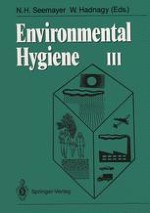1992 | OriginalPaper | Chapter
Urinary Alkylpurines as Markers of Alkylating Agent Exposure in Humans
Authors : V. Prevost, D. E. G. Shuker, H. Bartsch
Published in: Environmental Hygiene III
Publisher: Springer Berlin Heidelberg
Included in: Professional Book Archive
Activate our intelligent search to find suitable subject content or patents.
Select sections of text to find matching patents with Artificial Intelligence. powered by
Select sections of text to find additional relevant content using AI-assisted search. powered by
The mechanism of action of many carcinogens is considered to involve the formation of electrophilic alkylating agents which react with nucleophilic sites in DNA giving rise to a range of adducts (Miller, 1978). All of the nitrogen and oxygen atoms in purines and pyrimidines are known to form adducts with various carcinogens, although the relative amounts of each adduct vary greatly depending on the reactivity of the alkylating species (Singer and Kusmierek, 1982). O6-alkylguanine adducts are promutagenic lesions which can be repaired by alkyltransferases which remove the alkyl group. In contrast, N7- and N3-purine adducts are repaired by glycosylases which excise the alkylated base (Karran and Lindahl, 1985). Excised alkylpurines are known to be resistant to catabolism and are excreted in urine. These observations are the basis of methods for the non-invasive measurement of human exposure to alkylating carcinogens using excreted DNA adducts (Shuker, 1989). This approach has been particularly successful in studies on human exposure to aflatoxin B1 (Groopman et al., 1991).
